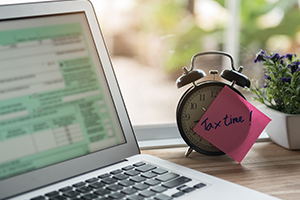
It is often said that the only thing constant in our lives is ‘change’. Indeed, this is true. Your likes and dislikes change over a period of time, your goals and requirements keep changing, and correspondingly, so does the investment climate. If everything changes, then why should your portfolio remain the same?
Let’s take the example of three individuals, Ravi, Manish, and Sheena.
Ravi, who is 35 years now, started his investment journey early on at the age of 24 years. At that time, he was earning very little and also had to pay off his education loan. As a result, his risk taking ability was very low and thus, around 30% of his investments were inequity instrumentsand 40% of his investments were in debt investments. He paid off his education loan by the time he turned 25 and over the years, his salary has grown substantially. However, he did not make any changes to his investment portfolio. Today, when he is 37 years, he has still not accumulated enough money to meet his goal of buying a house. He is very confused. Since he had been investing for the last 13 years, he thought that he would be able to meet this goal. He did not know where he went wrong.
Manish, on the other hand, has always maintained a balanced portfolio. He invests 50% of the portfolio money in equity instruments and 50% indebt instruments. This way, he believes that if the equity markets were to go into a downfall, only 50% of his portfolio would get impacted. Manish is very happy with his portfolio performance. Over the last one year, the equity market has been going up and along with that , so has his investment portfolio. However, just like everything in life changes, the equity markets also changed direction and started witnessing a steep fall. While Manish was concerned, he was not very worried since he believed that only 50% of his portfolio would get impacted. However, when he reviewed his portfolio, almost 65% of it had taken a hit. Manish was shocked to see such a big loss. He did not know where he went wrong.
And then there is Sheena. She had a goal to buy a luxury car in 6 years. Taking into consideration her risk-return requirements and her investment time horizon, she invested 20% of her money in an equity mutual fund and 80% in a mix of debt mutual funds and other fixed-income instruments. Now, in year 5, she looked at her portfolio and was satisfied to see that the equity investments had grown substantially and that she was well-positioned to purchase her dream car the next year. However, when the time came to buy a car, she was in for a shock. Over the previous one year, the equity market had fallen sharply as a result of which the value of the equity part of the portfolio had gone down significantly. Despite having started saving and investing for this goal 6 years back, she was still not able to achieve it. She did not know where she went wrong.
Where did they go wrong? All three of them, i.e., Ravi, Manish, and Sheena forgot to periodically review and rebalance their portfolio.
Importance of periodic portfolio review and rebalancing
One of the most important ways to create a robust investment portfolio that can help you achieve your financial goals is asset allocation. This entails investing in a mix of investment instruments across equity, debt, commodities, etc. The idea behind asset allocation is that different investments react differently to a similar set of developments and new flows. As a result, when one investment might go down or perform poorly, another investment in your portfolio might do well. This way, the risk of your portfolio gets spread out amongst multiple investments, thereby protecting portfolio downside and also potentially enhancing portfolio returns. Now, asset allocation is done taking into consideration three primary factors. These include:
- Your return requirements
- Your risk profile
- Your investment time period
Depending on the above, you can decide how much to invest in equities, how much in debt, and how much in other instruments. However, it is important to understand that your return requirements, risk profile, and investment time period do not remain constant. They can keep changing . Further, the investment climate can also keep changing. Thus, to ensure that you remain on track to achieving your goals and your investment portfolio reflects your risk profile, it is important for you to periodically review and rebalance, if required, your portfolio.
Portfolio review and rebalancing entails looking at the composition of your current portfolio and then assessing whether the investments in your portfolio match your risk profile and are capable of helping you meet your financial requirements, in the time period that you desire. If not, then it is time to rebalance and change your portfolio to reflect the change in your circumstances and requirements.
When should you rebalance your investment portfolio?
There are three scenarios under which you should consider rebalancing
- Change in risk profile:When Ravi started his investing journey, he was young, had a small income, and also had a liability. As a result, he had a conservative risk profile, i.e., he could not take very high risk. Thus, his portfolio mainly comprised debt instruments. However, after he had paid off his education loan and he saw an increase in his salary, his risk profile shifted to moderate and maybe even aggressive. So, he could easily take on more risk by increasing his exposure to equities. He was young, had a good income, and no liabilities. His portfolio should have had more than 30% equities. What Ravi should have done is reviewed his portfolio and rebalanced it by buying more equity investments, preferably in the form of equity or hybrid mutual funds and reduced his exposure to debt instruments. Had he rebalanced his portfolio, the equity portion could have grown and helped him reach his goal of buying a house.
- Significant shift from asset allocation strategy:Often, when equity markets rally, the overall weight of equities in your portfolio can increase and go beyond the exposure assigned by your asset allocation strategy. When Manish started off, he had 50% invested in equity and 50% invested in debt. So, if he invested Rs. 100, then Rs, 50 was in equity and Rs. 50 was in debt. Now when markets started rallying, the value of the Rs. 50 invested in equity increased to Rs. 90. With this increase the total value of his portfolio became Rs. 140 and the exposure to equities became approximately 65%. Thus, when markets fell, nearly 65% of his portfolio got impacted. What Manish should have ideally done is reviewed his investment portfolio when markets started going up. On review he would have noticed that the proportion of equities is growing. This is where he should have chosen to consult an advisor and rebalance by selling some equity investments and bringing the proportion of equities in the portfolio back to 50%. Thus, by rebalancing, he could have ensured that he continues to follow his asset allocation strategy which would have helped him reduce the impact of a fall in equities. In a normal market scenario, you should consider reviewing your investment portfolio annually. On the other hand, if there are sharp market movements, then you can review your portfolio twice a year. A drift of 5 to 7% from your desired asset allocation may not require rebalancing. However, if you move away more than 10% from your asset allocation strategy then you must consider rebalancing.
- Getting closer to the goal:Most of us create an investment portfolio to achieve our financial goals. In the case of Sheena, she created a robust portfolio and was able to accumulate enough money to meet one of her goals. However, when the time came to exit her investments, the equity investments had fallen in value. What Sheena should have done is reviewed her portfolio when she was one year away from reaching her goal. At this point of time, she should have rebalanced her portfolio by redeeming her equity investments and moving that money to safer debt investments. This would have ensured that the gains made on her equity investments would be safeguarded so that when she finally reached year 6, she would have the money to buy her dream car. Again, rebalancing would have helped her to secure the gains that she had made.
Life is not static. Similarly, your financial plan and your asset allocation strategy should also not be static. If you really want to achieve your financial goals you must ensure that you invest as per your asset allocation strategy, periodically review your investment portfolio, and ensure that you rebalance it if there is a change in your circumstances, risk profile, return requirements, or the market.
As Darwin said, “It is not the strongest of the species that survive, nor the most intelligent, but the one more responsive to change.” Be responsive and rebalance to survive. An investor education initiative by Edelweiss Mutual Fund
All Mutual Fund Investors have to go through a onetime KYC process. Investor should deal only with Registered Mutual Fund (RMF). For more info on KYC, RMF and procedure to lodge/redress any complaints, visit -https://www.edelweissmf.com/kyc-norms
MUTUAL FUND INVESTMENTS ARE SUBJECT TO MARKET RISKS, READ ALL SCHEME RELATED DOCUMENTS CAREFULLY.
Trending Articles
MUTUAL FUND INVESTMENTS ARE SUBJECT TO MARKET RISKS, READ ALL SCHEME RELATED DOCUMENTS CAREFULLY.















